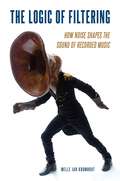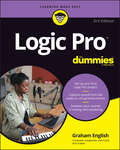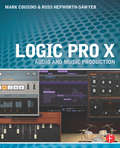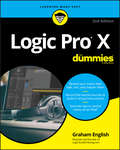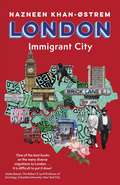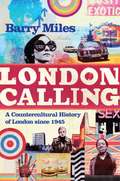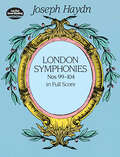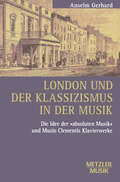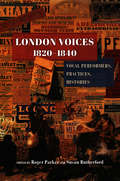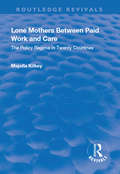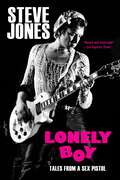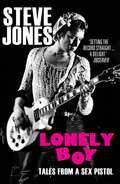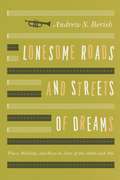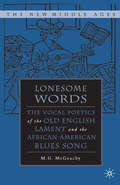- Table View
- List View
The Logic of Filtering: How Noise Shapes the Sound of Recorded Music
by Melle Jan KromhoutThe Logic of Filtering traces the profound impact of technical media on the sound of music, asking: how do media technologies shape sound? How does this affect music? And how did it change what we listen for in music? Since the invention of sound recording in the second half of the nineteenth century, media that transmit, record, store, and reproduce physical sound inspired dreams of perfect reproduction, but were also confronted with the inevitable introduction of noise. Based on a wide range of historical, technical and theoretical sources, author Melle Jan Kromhout explores this one hundred and forty-year history of sound media and shows why noise should not be understood as unwanted by-effect, but instead plays a foundational role in shaping the sonic contours of recorded music. The Logic of Filtering develops an extensive media archaeological analysis of the 'noise of sound media,' encompassing all the disturbances, distortions, and interferences that these media add to the sounds they reproduce. It thereby stands to enrich our understanding of the way in which sound media changed and continue to change the sonorous qualities of music, and offers new perspectives on the interaction between music, media and listeners.
Logic Pro For Dummies
by Graham EnglishThis one-stop source for Logic Pro insight helps you spend more time creating music Every minute you spend trying to figure out how to set up a new track or build a drum loop is a minute you don’t spend creating and recording your music. This guide to the recording software favored by Mac users helps you bypass the time needed to search for tech answers and spend more time capturing sounds. Discover the full recording power of Logic Pro, starting with launching a project and recording your audio. Explore the built-in digital instruments and beat makers, augment your recording power with plug-ins, and finalize your song by editing, adding effects, mixing, mastering, and sharing. The final step is music stardom! Learn your way around the Logic Pro interface and understand the workflow Set up your project and add tracks and regions Record acoustic audio or conduct your orchestra of MIDI instruments Edit, mix, automate, export, and feel proud of your audio filesFor beginning music creators and producers, this Dummies guide makes it simple to get started with Logic Pro.
Logic Pro For Dummies
by Graham EnglishThis one-stop source for Logic Pro insight helps you spend more time creating music Every minute you spend trying to figure out how to set up a new track or build a drum loop is a minute you don’t spend creating and recording your music. This guide to the recording software favored by Mac users helps you bypass the time needed to search for tech answers and spend more time capturing sounds. Discover the full recording power of Logic Pro, starting with launching a project and recording your audio. Explore the built-in digital instruments and beat makers, augment your recording power with plug-ins, and finalize your song by editing, adding effects, mixing, mastering, and sharing. The final step is music stardom! Learn your way around the Logic Pro interface and understand the workflow Set up your project and add tracks and regions Record acoustic audio or conduct your orchestra of MIDI instruments Edit, mix, automate, export, and feel proud of your audio filesFor beginning music creators and producers, this Dummies guide makes it simple to get started with Logic Pro.
Logic Pro X: Audio and Music Production
by Mark Cousins Russ Hepworth-SawyerFrom initial demos to mixing and mastering, seasoned authors Mark Cousins and Russ Hepworth-Sawyer show you how to get the most from Logic Pro X. By exploring the essential workflow and the creative possibilities offered by Logic’s virtual instruments and effects, Logic Pro X: Audio and Music Production leads you through the music creation and production process, giving you all the tips and tricks used by the pros to create release-quality recordings. Using full color screenshots throughout, alongside related boxouts that expand on the key concepts, Logic Pro X: Audio and Music Production is an informative and easy-to-read guide to using Logic Pro X. Key features include: Production FAQs – Instructional Walkthroughs and Knowledgebases present information clearly and answer common production–specific problems. Methods – Professional techniques for recording and editing in Logic Pro X – whether you’re dealing with real musicians or cutting-edge virtual instruments. Workflow – Use Logic Pro X’s tools and functions in an optimal way. Website – Access audio examples, samples (Apple Loops), Logic projects, sampler instruments, and instrument patches at www.focalpress.com/cw/cousins Logic Pro X: Audio and Music Production covers more than just the software; it will help you make the most out of every recording session and will illuminate and inspire your creative and sonic endeavors!
Logic Pro X: Audio and Music Production
by Mark Cousins Russ Hepworth-SawyerFrom initial demos to mixing and mastering, seasoned authors Mark Cousins and Russ Hepworth-Sawyer show you how to get the most from Logic Pro X. By exploring the essential workflow and the creative possibilities offered by Logic’s virtual instruments and effects, Logic Pro X: Audio and Music Production leads you through the music creation and production process, giving you all the tips and tricks used by the pros to create release-quality recordings. Using full color screenshots throughout, alongside related boxouts that expand on the key concepts, Logic Pro X: Audio and Music Production is an informative and easy-to-read guide to using Logic Pro X. Key features include: Production FAQs – Instructional Walkthroughs and Knowledgebases present information clearly and answer common production–specific problems. Methods – Professional techniques for recording and editing in Logic Pro X – whether you’re dealing with real musicians or cutting-edge virtual instruments. Workflow – Use Logic Pro X’s tools and functions in an optimal way. Website – Access audio examples, samples (Apple Loops), Logic projects, sampler instruments, and instrument patches at www.focalpress.com/cw/cousins Logic Pro X: Audio and Music Production covers more than just the software; it will help you make the most out of every recording session and will illuminate and inspire your creative and sonic endeavors!
Logic Pro X For Dummies
by Graham EnglishSpend less time learning and more time recording Logic Pro X offers Mac users the tools and power they need to create recordings ready to share with the world. This book provides the know-how for navigating the interface, tweaking the settings, picking the sounds, and all the other tech tasks that get in the way of capturing the perfect take. Written by a Logic Pro X trainer who’s used the software to further his own music career, Logic Pro X For Dummies cuts back on the time needed to learn the software and allows for more time making amazing recordings. Record live sound sources or built-in virtual instruments Arrange your tracks to edit, mix, and master Discover tips to speed the process and record on an iPad Make sense of the latest software updates A favorite among Logic Pro X beginners, this book is updated to reflect the ongoing changes added to enhance Logic Pro X’s recording power.
Logic Pro X For Dummies
by Graham EnglishSpend less time learning and more time recording Logic Pro X offers Mac users the tools and power they need to create recordings ready to share with the world. This book provides the know-how for navigating the interface, tweaking the settings, picking the sounds, and all the other tech tasks that get in the way of capturing the perfect take. Written by a Logic Pro X trainer who’s used the software to further his own music career, Logic Pro X For Dummies cuts back on the time needed to learn the software and allows for more time making amazing recordings. Record live sound sources or built-in virtual instruments Arrange your tracks to edit, mix, and master Discover tips to speed the process and record on an iPad Make sense of the latest software updates A favorite among Logic Pro X beginners, this book is updated to reflect the ongoing changes added to enhance Logic Pro X’s recording power.
London: Immigrant City
by Nazneen Khan-ØstremTRANSLATED BY ALISON McCULLOUGH'One of the best books on the many diverse migrations to London . . . revealing the extent to which the diversity of immigrant origins has had transformative effects - through food, music, diverse types of knowledge and so much more. The book is difficult to put it down'Saskia Sassen, The Robert S. Lynd Professor of Sociology, Columbia University, New York'The ultimate book about Great Britain's capital'Dagbladet'One of the best books of the year! . . . This is a book about what a city is and can be'AftenpostenIs there a street in London which does not contain a story from the Empire? Immigrants made London; and they keep remaking it in a thousand different ways. Nazneen Khan-Østrem has drawn a wonderful new map of a city that everyone thought they already knew. She travels around the city, meeting the very people who have created a truly unique metropolis, and shows how London's incredible development is directly attributable to the many different groups of immigrants who arrived after the Second World War, in part due to the Nationality Act of 1948. Her book reveals the historical, cultural and political changes within those communities which have fundamentally transformed the city, and which have rarely been considered alongside each other.Nazneen Khan-Østrem has a cosmopolitan background herself, being a British, Muslim, Asian woman, born in Nairobi and raised in the UK and Norway, which has helped her in unravelling the city's rich immigrant history and its constant ongoing evolution.Drawing on London's rich literature and its musical heritage, she has created an intricate portrait of a strikingly multi-faceted metropolis. Based on extensive research, particularly into aspects not generally covered in the wide array of existing books on the city, London manages to capture the city's enticing complexity and its ruthless vitality.This celebration of London's diverse immigrant communities is timely in the light of the societal fault lines exposed by the Covid-19 pandemic and Brexit. It is a sensitive and insightful book that has a great deal to say to Londoners as well as to Britain as a whole.
London Calling: A Countercultural History of London since 1945
by Barry MilesLondon has long been a magnet for aspiring artists and writers, musicians and fashion designers seeking inspiration and success. In London Calling, Barry Miles explores the counter-culture - creative, avant garde, permissive, anarchic - that sprang up in this great city in the decades following the Second World War. Here are the heady post-war days when suddenly everything seemed possible, the jazz bars and clubs of the fifties, the teddy boys and the Angry Young Men, Francis Bacon and the legendary Colony Club, the 1960s and the Summer of Love, the rise of punk and the early days of the YBAs. The vitality and excitement of this time and years of change - and the sheer creative energy in the throbbing heart of London - leap off the pages of this evocative and original book.
London Symphonies Nos. 99-104 in Full Score
by Joseph HaydnIt was in his monumental 12 "London" symphonies, composed between 1791 and 1795, that Haydn shaped the early form of the symphony and set the standard for later composers. According to the New Grove's Dictionary of Music and Musicians, the appeal of these works stems from their stature as "grand" symphonies, embodying a "broader presentation of musical ideas" and "themes and motifs of a basic simplicity and immediate appeal."The present volume contains the last six symphonies in the series, including the lively "Military" Symphony (No. 100), the delightful "Clock" Symphony (No. 101), and the world-famous "London" Symphony (No. 104).Scores included in this volume are Symphony No. 99 in E-flat Major; Symphony No. 100 in G Major ("Military"); Symphony No. 101 in D Major ("The Clock"); Symphony No. 102 in B-flat Major; Symphony No. 103 in E-flat Major ("Dumroll"); and Symphony No. 104 in D Major ("London").The attractive qualities of these works have made them perennial favorites with musicians and concertgoers for over two hundred years. Now music lovers can study and enjoy the elegant structure and polished orchestration of these enduring masterpieces in this authoritative full-score edition.
London und der Klassizismus in der Musik: Die Idee der 'absoluten Musik' und Muzio Clementis Klavierwerke
by Anselm GerhardLondon, die musikalische Hauptstadt des 18. Jahrhunderts. Von der Metropole gingen damals viele Impulse sowohl für den Musikmarkt als auch für die klassizistische Kunsttheorie aus. Musiker wie Haydn hat dies entscheidend geprägt. Der Autor eröffnet einen neuen Blick auf das enge Wechselverhältnis von Musikmarkt, Musikästhetik und Kompositionspraxis der Klassik, deren Geschichte um 1780 in London begann.
London Voices, 1820–1840: Vocal Performers, Practices, Histories
by Roger Parker Susan RutherfordLondon, 1820. The British capital is a metropolis that overwhelms dwellers and visitors alike with constant exposure to all kinds of sensory stimulation. Over the next two decades, the city’s tumult will reach new heights: as population expansion places different classes in dangerous proximity and ideas of political and social reform linger in the air, London begins to undergo enormous infrastructure change that will alter it forever. It is the London of this period that editors Roger Parker and Susan Rutherford pinpoint in this book, which chooses one broad musical category—voice—and engages with it through essays on music of the streets, theaters, opera houses, and concert halls; on the raising of voices in religious and sociopolitical contexts; and on the perception of voice in literary works and scientific experiments with acoustics. Emphasizing human subjects, this focus on voice allows the authors to explore the multifaceted issues that shaped London, from the anxiety surrounding the city’s importance in the musical world at large to the changing vocal imaginations that permeated the epoch. Capturing the breadth of sonic stimulations and cultures available—and sometimes unavoidable—to residents at the time, London Voices, 1820–1840 sheds new light on music in Britain and the richness of London culture during this period.
London Voices, 1820–1840: Vocal Performers, Practices, Histories
by Roger Parker Susan RutherfordLondon, 1820. The British capital is a metropolis that overwhelms dwellers and visitors alike with constant exposure to all kinds of sensory stimulation. Over the next two decades, the city’s tumult will reach new heights: as population expansion places different classes in dangerous proximity and ideas of political and social reform linger in the air, London begins to undergo enormous infrastructure change that will alter it forever. It is the London of this period that editors Roger Parker and Susan Rutherford pinpoint in this book, which chooses one broad musical category—voice—and engages with it through essays on music of the streets, theaters, opera houses, and concert halls; on the raising of voices in religious and sociopolitical contexts; and on the perception of voice in literary works and scientific experiments with acoustics. Emphasizing human subjects, this focus on voice allows the authors to explore the multifaceted issues that shaped London, from the anxiety surrounding the city’s importance in the musical world at large to the changing vocal imaginations that permeated the epoch. Capturing the breadth of sonic stimulations and cultures available—and sometimes unavoidable—to residents at the time, London Voices, 1820–1840 sheds new light on music in Britain and the richness of London culture during this period.
London Voices, 1820–1840: Vocal Performers, Practices, Histories
London, 1820. The British capital is a metropolis that overwhelms dwellers and visitors alike with constant exposure to all kinds of sensory stimulation. Over the next two decades, the city’s tumult will reach new heights: as population expansion places different classes in dangerous proximity and ideas of political and social reform linger in the air, London begins to undergo enormous infrastructure change that will alter it forever. It is the London of this period that editors Roger Parker and Susan Rutherford pinpoint in this book, which chooses one broad musical category—voice—and engages with it through essays on music of the streets, theaters, opera houses, and concert halls; on the raising of voices in religious and sociopolitical contexts; and on the perception of voice in literary works and scientific experiments with acoustics. Emphasizing human subjects, this focus on voice allows the authors to explore the multifaceted issues that shaped London, from the anxiety surrounding the city’s importance in the musical world at large to the changing vocal imaginations that permeated the epoch. Capturing the breadth of sonic stimulations and cultures available—and sometimes unavoidable—to residents at the time, London Voices, 1820–1840 sheds new light on music in Britain and the richness of London culture during this period.
Lone Mothers Between Paid Work and Care: The Policy Regime in Twenty Countries (Routledge Revivals)
by Majella KilkeyThis title was first published in 2000. This is a study which compares and contrasts how lone mothers' relationships to paid work and care-giving are constructed across 20 countries, and with what outcomes for lone mothers' levels of economic well-being. In doing so, the book explores from an international perspective, the implications of the re-orientation of lone mothers' citizenship within the UK policy field from that of care-giver to paid worker. The volume engages with feminist comparative social policy literature concerned with specifying a construction of citizenship appropriate to capturing international variations in women's social rights. By incorporating social rights attached to paid work and care, as well as those which enable lone mothers to move between sequential periods of paid work and care-giving across the child-rearing cycle, the study makes a significant contribution to the literature.
Lone Mothers Between Paid Work and Care: The Policy Regime in Twenty Countries (Routledge Revivals)
by Majella KilkeyThis title was first published in 2000. This is a study which compares and contrasts how lone mothers' relationships to paid work and care-giving are constructed across 20 countries, and with what outcomes for lone mothers' levels of economic well-being. In doing so, the book explores from an international perspective, the implications of the re-orientation of lone mothers' citizenship within the UK policy field from that of care-giver to paid worker. The volume engages with feminist comparative social policy literature concerned with specifying a construction of citizenship appropriate to capturing international variations in women's social rights. By incorporating social rights attached to paid work and care, as well as those which enable lone mothers to move between sequential periods of paid work and care-giving across the child-rearing cycle, the study makes a significant contribution to the literature.
Lonely Boy: Tales from a Sex Pistol
by Steve JonesWithout the Sex Pistols there would be no punk. And without Steve Jones there would be no Sex Pistols. It was Steve who, with his schoolmate Paul Cook, formed the band that eventually went on to become the Sex Pistols and who was its original leader. As the world celebrates the 40th anniversary of punk--the influence and cultural significance of which is felt in music, fashion, and the visual arts to this day--Steve tells his story for the very first time.Steve Jones's modern Dickensian tale began in the street of Hammersmith and Shepherd's Bush, West London, where as a lonely, neglected boy living off his wits and petty thievery he was given purpose by the glam art rock of David Bowie and Roxy Music. He became one of the first generation of ragamuffin punks taken under the wings of Malcolm McLaren and Vivienne Westwood.In Lonely Boy, Steve describes the sadness of never having known his real dad, the abuse he suffered at the hands of his stepfather, and how his interest in music and fashion saved him from a potential life of crime spent in remand centers and prisons. He takes readers on his journey from the Kings Road of the early '70s through the years of the Sex Pistols, punk rock, and the recording of "Anarchy in the UK" and Never Mind the Bollocks. He recounts his infamous confrontation on Bill Grundy's Today program--the interview that ushered in the "Filth and the Fury" headlines that catapulted punk into the national consciousness. And he delves into the details of his self-imposed exile in New York and Los Angeles, where he battled alcohol, heroin, and sex addiction but eventually emerged to gain fresh acclaim as an actor and radio host.Lonely Boy is the story of an unlikely guitar hero who, with the Sex Pistols, transformed twentieth-century culture and kick-started a social revolution.
Lonely Boy: Tales from a Sex Pistol
by Steve JonesForeword by Chrissie HyndeWithout the Sex Pistols there would be no Punk. And without Steve Jones there would be no Sex Pistols. It was Steve who formed Kutie Jones and his Sex Pistols, the band that eventually went on to become the Sex Pistols, with his schoolmate Paul Cook and who was its original leader. As the world celebrates the 40th anniversary of Punk – the influence and cultural significance of which is felt in music, fashion and the visual arts to this day – Steve tells his story for the very first time. Steve’s modern Dickensian tale begins in the streets of Hammersmith and Shepherd’s Bush, West London, where as a lonely, neglected boy living off his wits and petty thievery he is given purpose by the glam art rock of David Bowie and Roxy Music and becomes one of the first generation of ragamuffin punks taken under the wings of Malcolm McLaren and Vivienne Westwood. For the very first time Steve describes the sadness of never having known his dad, the neglect and abuse he suffered at the hands of his step father, and how his interest in music and fashion saved him from a potential life of crime spent in remand centres and prison. From the Kings Road of the early seventies, through the years of the Sex Pistols, Punk Rock and the recording of Never Mind the Bollocks (ranked number 41 in Rolling Stone magazine’s Best Albums of All Time), to his self-imposed exile in New York and Los Angeles where he battled with alcohol, heroin and sex addiction – caught in a cycle of rehab and relapse – Lonely Boy, written with music journalist and author Ben Thompson, is the story of an unlikely guitar hero who, with the Sex Pistols, changed history.
Lonesome Roads and Streets of Dreams: Place, Mobility, and Race in Jazz of the 1930s and '40s
by Andrew S. BerishAny listener knows the power of music to define a place, but few can describe the how or why of this phenomenon. In Lonesome Roads and Streets of Dreams: Place, Mobility, and Race in Jazz of the 1930s and ’40s, Andrew Berish attempts to right this wrong, showcasing how American jazz defined a culture particularly preoccupied with place. By analyzing both the performances and cultural context of leading jazz figures, including the many famous venues where they played, Berish bridges two dominant scholarly approaches to the genre, offering not only a new reading of swing era jazz but an entirely new framework for musical analysis in general, one that examines how the geographical realities of daily life can be transformed into musical sound. Focusing on white bandleader Jan Garber, black bandleader Duke Ellington, white saxophonist Charlie Barnet, and black guitarist Charlie Christian, as well as traveling from Catalina Island to Manhattan to Oklahoma City, Lonesome Roads and Streets of Dreams depicts not only a geography of race but how this geography was disrupted, how these musicians crossed physical and racial boundaries—from black to white, South to North, and rural to urban—and how they found expression for these movements in the insistent music they were creating.
Lonesome Roads and Streets of Dreams: Place, Mobility, and Race in Jazz of the 1930s and '40s
by Andrew S. BerishAny listener knows the power of music to define a place, but few can describe the how or why of this phenomenon. In Lonesome Roads and Streets of Dreams: Place, Mobility, and Race in Jazz of the 1930s and ’40s, Andrew Berish attempts to right this wrong, showcasing how American jazz defined a culture particularly preoccupied with place. By analyzing both the performances and cultural context of leading jazz figures, including the many famous venues where they played, Berish bridges two dominant scholarly approaches to the genre, offering not only a new reading of swing era jazz but an entirely new framework for musical analysis in general, one that examines how the geographical realities of daily life can be transformed into musical sound. Focusing on white bandleader Jan Garber, black bandleader Duke Ellington, white saxophonist Charlie Barnet, and black guitarist Charlie Christian, as well as traveling from Catalina Island to Manhattan to Oklahoma City, Lonesome Roads and Streets of Dreams depicts not only a geography of race but how this geography was disrupted, how these musicians crossed physical and racial boundaries—from black to white, South to North, and rural to urban—and how they found expression for these movements in the insistent music they were creating.
Lonesome Roads and Streets of Dreams: Place, Mobility, and Race in Jazz of the 1930s and '40s
by Andrew S. BerishAny listener knows the power of music to define a place, but few can describe the how or why of this phenomenon. In Lonesome Roads and Streets of Dreams: Place, Mobility, and Race in Jazz of the 1930s and ’40s, Andrew Berish attempts to right this wrong, showcasing how American jazz defined a culture particularly preoccupied with place. By analyzing both the performances and cultural context of leading jazz figures, including the many famous venues where they played, Berish bridges two dominant scholarly approaches to the genre, offering not only a new reading of swing era jazz but an entirely new framework for musical analysis in general, one that examines how the geographical realities of daily life can be transformed into musical sound. Focusing on white bandleader Jan Garber, black bandleader Duke Ellington, white saxophonist Charlie Barnet, and black guitarist Charlie Christian, as well as traveling from Catalina Island to Manhattan to Oklahoma City, Lonesome Roads and Streets of Dreams depicts not only a geography of race but how this geography was disrupted, how these musicians crossed physical and racial boundaries—from black to white, South to North, and rural to urban—and how they found expression for these movements in the insistent music they were creating.
Lonesome Roads and Streets of Dreams: Place, Mobility, and Race in Jazz of the 1930s and '40s
by Andrew S. BerishAny listener knows the power of music to define a place, but few can describe the how or why of this phenomenon. In Lonesome Roads and Streets of Dreams: Place, Mobility, and Race in Jazz of the 1930s and ’40s, Andrew Berish attempts to right this wrong, showcasing how American jazz defined a culture particularly preoccupied with place. By analyzing both the performances and cultural context of leading jazz figures, including the many famous venues where they played, Berish bridges two dominant scholarly approaches to the genre, offering not only a new reading of swing era jazz but an entirely new framework for musical analysis in general, one that examines how the geographical realities of daily life can be transformed into musical sound. Focusing on white bandleader Jan Garber, black bandleader Duke Ellington, white saxophonist Charlie Barnet, and black guitarist Charlie Christian, as well as traveling from Catalina Island to Manhattan to Oklahoma City, Lonesome Roads and Streets of Dreams depicts not only a geography of race but how this geography was disrupted, how these musicians crossed physical and racial boundaries—from black to white, South to North, and rural to urban—and how they found expression for these movements in the insistent music they were creating.
Lonesome Roads and Streets of Dreams: Place, Mobility, and Race in Jazz of the 1930s and '40s
by Andrew S. BerishAny listener knows the power of music to define a place, but few can describe the how or why of this phenomenon. In Lonesome Roads and Streets of Dreams: Place, Mobility, and Race in Jazz of the 1930s and ’40s, Andrew Berish attempts to right this wrong, showcasing how American jazz defined a culture particularly preoccupied with place. By analyzing both the performances and cultural context of leading jazz figures, including the many famous venues where they played, Berish bridges two dominant scholarly approaches to the genre, offering not only a new reading of swing era jazz but an entirely new framework for musical analysis in general, one that examines how the geographical realities of daily life can be transformed into musical sound. Focusing on white bandleader Jan Garber, black bandleader Duke Ellington, white saxophonist Charlie Barnet, and black guitarist Charlie Christian, as well as traveling from Catalina Island to Manhattan to Oklahoma City, Lonesome Roads and Streets of Dreams depicts not only a geography of race but how this geography was disrupted, how these musicians crossed physical and racial boundaries—from black to white, South to North, and rural to urban—and how they found expression for these movements in the insistent music they were creating.
Lonesome Roads and Streets of Dreams: Place, Mobility, and Race in Jazz of the 1930s and '40s
by Andrew S. BerishAny listener knows the power of music to define a place, but few can describe the how or why of this phenomenon. In Lonesome Roads and Streets of Dreams: Place, Mobility, and Race in Jazz of the 1930s and ’40s, Andrew Berish attempts to right this wrong, showcasing how American jazz defined a culture particularly preoccupied with place. By analyzing both the performances and cultural context of leading jazz figures, including the many famous venues where they played, Berish bridges two dominant scholarly approaches to the genre, offering not only a new reading of swing era jazz but an entirely new framework for musical analysis in general, one that examines how the geographical realities of daily life can be transformed into musical sound. Focusing on white bandleader Jan Garber, black bandleader Duke Ellington, white saxophonist Charlie Barnet, and black guitarist Charlie Christian, as well as traveling from Catalina Island to Manhattan to Oklahoma City, Lonesome Roads and Streets of Dreams depicts not only a geography of race but how this geography was disrupted, how these musicians crossed physical and racial boundaries—from black to white, South to North, and rural to urban—and how they found expression for these movements in the insistent music they were creating.
Lonesome Words: The Vocal Poetics of the Old English Lament and the African-American Blues Song (The New Middle Ages)
by M. McGeachyThe tenth-century Old English lament and twentieth-century blues song each speak the language of a distinct poetic tradition, yet the voices are remarkably similar in their emotive expression of loneliness. This innovative study juxtaposes the texts of each corpus to explore the features that characterize their vocal poetics
